Do bearded dragons drink water?
Yes. Bearded dragons, like any other critter, need water to survive and be healthy. While in their natural habitat, they get it from the plant materials and live foods such as invertebrates such as insects and smaller vertebrates such as smaller lizards.
Furthermore, they may drink standing water, dew, mist, and rainwater, i.e., when it rains, they will incline their body by lowering their forelimbs while keeping back ones raised. This posture to allow rainwater trapped by their bumps and spines to flow along their body to their head and snout before they can drink it using their tongue.
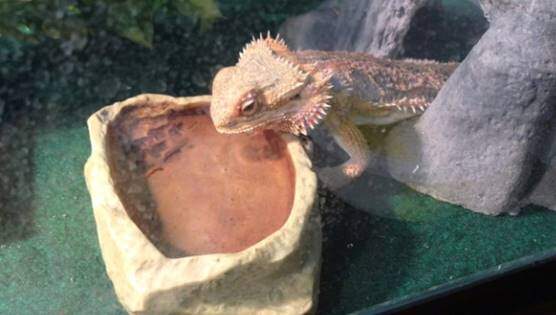
Thirdly, since their natural habitat is arid or semi-arid, beardies have a mechanism of conserving water to stay hydrated. They do so by passing out dry urine. The chalky stuff that accompanies their poop Is their urine.
In captivity, these pets need water too to stay hydrated. Therefore, it means you have to provide them with clean, drinking water or find ways of keeping them hydrated.
How much water should do they drink?
Beardies require 10-30 ml of water per kilogram of their body weight. Since bearded dragon weight ranges from 0.62 – 1.1 lbs, they need 4.5-15 ml depending on their weight.
However, this may not determine the amount they will drink since they get some amount from their fresh or live foods.
How often do should they drink water?
Since they can thrive well in desertic, arid, and semi-arid areas such as those that prevail in their natural habitats in Australia, these pets can thrive well without having to drink water regularly. They will get it from the various live feeder insects, greens, and veggies as well as fruit treats.
Secondly, as already hinted, their kidneys are very efficient in both conserving fluids as well as extracting moisture from food. Their urinary excretes to the cloaca, which is the posterior orifice where they will try to get as much water as possible (from urine and gastrointestinal tract fluids), leaving behind dry urine (a semi-solid white part in their fecal matter).
Do not be worried if your beardie has not been taking much water since, as noted, they can live even though they may not seem to be taking water. However, you need to ensure these reptiles aren’t dehydrated.
Dehydration symptoms
One way of telling your bearded dragons are dehydrated is by looking at their skin, mouth, and eyes. When dehydrated, their eyes will appear sunken, and their skin will be wrinkly and less elastic since they are dehydrated. Also, their saliva will form strands as it opens its mouth since it will be tackier.
Furthermore, in case they are shedding, it will be slower and troublesome, their mucous membrane will be tackier, and they will poop less, be lethargic, among other symptoms.
Furthermore, check their poop. If it is bright-white, these reptiles are well hydrated, if slightly yellow, consider increasing hydration, and if it is hard or yellow, they are dehydrated. Take the necessary measures to keep them hydrated.
Finally, you need to be extra keen if you have baby bearded dragons as they tend to get dehydrated quickly as opposed to an adult.
Do they drink tap water or distilled?
What kind of water do beardies drink? Should I give them bottled, distilled, or tap water?
The most recommended one is regular tap or bottled water. In the case of tap water, add Zoo Med ReptiSafe to remove any chlorine or chloramines or detoxify nitrates and ammonia. It will also help in balancing electrolytes and ions.
However, avoid distilled one since over 99.9% of vital minerals present will be gotten rid of during the distillation process.
How do beardies drink water in captivity?
In captivity, there are various ways by which these pets can drink water or be hydrated. Some of the common ways they do so include:
1. Eating fresh veggies and live foods
Fresh vegetables and greens contain water, especially staples veggies such as turnip greens, squashes, alfalfa sprout, collard greens, endive, escarole, mustard greens, cactus pad, and prickly pear.
Also, instead of going for freeze-dried crickets, mealworms, or other insects, go for live feeder insects as they will provide extra hydration. Live crickets, mealworms, silkworms, grasshoppers, and cockroaches will be a great source of hydration.
Finally, fruit treats, including mangoes, zucchinis, watermelon, cucumber, and so forth, will ensure they stay hydrated.
2. Using water dishes or bowls
The other way these pets stay hydrated is by giving them water. Some beardies will drink from their bowls while others will not. Therefore, always include a bowl on the cooler side as their hydration point.
From our experience, it is not easy to see drinking from bowls or dishes because as it is not how they do it naturally. However, others will.
Each day, replace their water in their bowl daily or if they swim, defecate or soil it, including with their food. Do this after cleaning the dish
The Zoo Med Wipe Out is an excellent product for disinfecting, cleaning, and deodorizing your bowl. If you are using the dishwasher, thoroughly rinse it to get rid of any remnant detergent.
3. Bathing
One strategy of ensuring these lizards stay hydrated is bathing them a few times in a month or about 1-2 times a week or more if they are shedding. Use a non-tippable shallow bowl (water should not reach their vents). A rock or ceramic bowl will be the most natural one.
When bathing them, use lukewarm water at about 85 degrees to soak them for not more than 15 minutes. During the bathing, these reptiles will drink some water while others will not. Baths help stimulate drinking.
Sometimes, after taking a poo, this pet may walk over it and then into their watering bowl and vivarium soiling them or soak themselves in the bowls for the same reason. Clean and disinfect these dishes afterward.
Avoid frequent baths as they will increase the risks of ear infection, eye problems if you chlorinated or respiratory infections.
Since you use lukewarm water, bathing will help in muscle relaxation, and your beardie may empty its bowels as well as have bowel movements if constipated. Afterward, disinfect bathing bowls or tubs.
Bathing will also help them shed, keep their skin healthy, and exercise them. Furthermore, besides dealing with overheating, a bath is useful if these pets are soiled, constipated, or impacted. However, use betadine soak if it has a wound.
It is not uncommon to find your beardie lying in his water bowl or swimming. Even as you bathe it, you can afterward allow them to swim for up to 30 minutes and place them on a cloth or paper towel and take them to their basking area once they finish swimming.
How to get a bearded dragon to drink water
Since they aren’t wired drink from bowls as they may not recognize stagnant water, some may not drink at all. Here are a few tips on training them to drink from them
To begin with, add a small amount of 100% fresh juice, such as pear or apple juice, to entice them. However, avoid orange, lemon, lime, or any other citrus juice and other unsafe fruits.
The juice aroma should entice them. If not, add more juice and see if these lizards will drink it. Once they get used to drinking from the bowl, start using water only.
Drip some water into a shallow bowl to make your beardie see as if it is raining into a pool. Some will make it recognize it. Repeat this until your beardies learn to drink on their own.
As you bathe them, splash some on its head and nose to help them know that the bathing water is also for drinking.
Are waterfalls or fountain necessary?
Water cascading down the waterfall may stimulate natural drinking. Unfortunately, it can also raise humidity. If you use it in your beardies tank, let it stay for a short time and continuously monitor the tank’s humidity. Otherwise, you should avoid it.
Best bearded dragon water bowls
There are several great water dishes you can use that are so natural and will make your vivarium look great. Some will even work as food dishes. Great dishes should:
- Have low sides to make drinking easy
- Not tip
- Durable
- Be natural looking
- Be easy to clean since you have to do this daily or if soiled.
- They should be shallow and easy to come out of in case these pets they fall inside these dishes to avoid drowning.
If you need water bowl or a combo to also use for feeding your beardie, some of the very best brands to buy include the following:
1. Exo Terra Water Dish – Small, Medium, Large and Extra Large
The Exo Terra brand is one of the super bowls for your beardies, other reptiles where you have a choice of going for a small, medium, large or extra-large dish. Larger ones will take more space, and the XL can allow these pets to soak themselves inside the bowl.
Besides being functional, it has a natural rock outside finish, a smooth coated surface without pits on the inside, to make cleaning easier and stop bacteria from thriving. It has safety ramps to allow them to crawl in and out, especially for smaller pets, minimizing drowning chances.
Finally, its neutral colors will make it look great in desert, rainforest, or tropical themed terrariums, and its food-grade resin material of construction makes it safe to these pets.
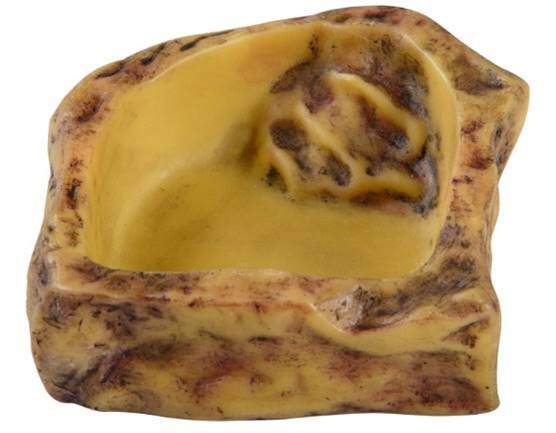
2. Zoo Med Reptile Ramp Bowl
This bowl comes in small, large, and extra-large size and features a ramp for crawling in and out effortlessly. The extra-large one is good for lizards, including bearded dragons, frogs, toads, salamanders, snakes, and so on.
Available in varying colors, you can create a perfect well-blended terrarium that that matches other décor or furniture and tank accessories.

3. Zoo Med Reptile Reservoir
This reptile dish with a 22-ounce reservoir will ensure clean drinking water is available continuously in your terrariums. It has a small basin to prevent your pets from soiling, is easy to clean, has an inbuilt cricket guard, and a broad base to stop it from accidental tipping.
Zoo Med Reptile Reservoir is a must-have if you have busy schedules or go on vacations as it will ensure your pet has all the water she needs.
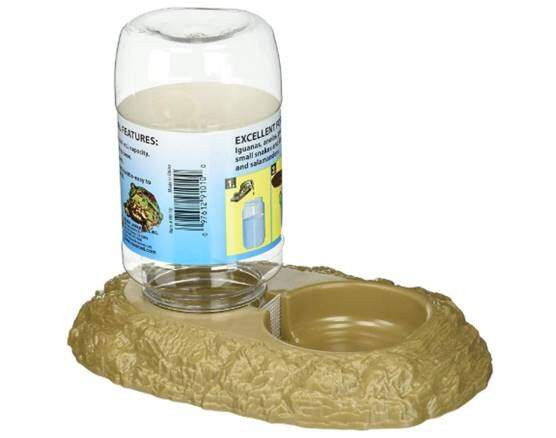
4. Zoo Med Repti Rock Food and Water Dish
This combo dish is perfect for is feeding and watering these reptiles. It features a smooth, nonporous surface without pits. Furthermore, it will not leak, get stained, or allow bacteria to thrive on it.
Finally, its polystyrene material will withstand harsh use conditions, and you have a choice of picking a small, large or X-large.
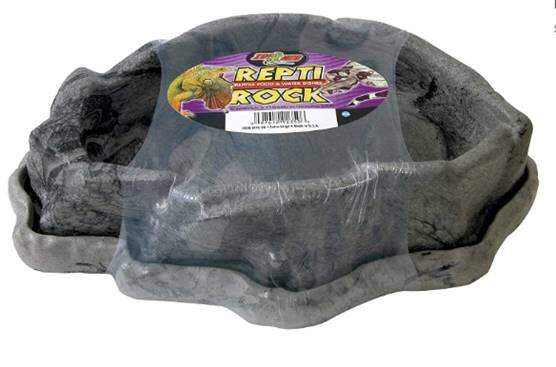
5. Zoo Med Reptile Rock Water Dish
Made from polystyrene, this unbreakable dish from Zoo Med comes in various colors. It is easy to clean, does not release any toxins, and is very durable. Furthermore, its non-porous and non-pitted surface will ensure it does not get stains, leak, or absorb any harmful bacteria.
Finally, you can choose a size that best fits your beardies as it in four sizes, the small, medium, large, and extra-large.
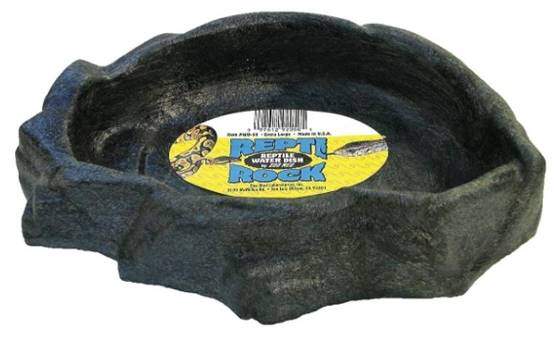
6. Fluker’s Food/Water Reptile Corner Bowl
This natural-looking shallow, high-quality water or food bowl that fits well into the corner of your terrarium, making it an excellent choice if you want to save space, i.e., it will leave pets more with more space to themselves.
Another reason to buy it is that it is easy to clean or disinfect, is safe to these pets, and you have a choice of going for a small, medium or large size depending on the size of your beardie.
While the Zoo Med has a superb corner bowl, it is a little too deep, a reason to stick to this Fluker’s corner bowl.
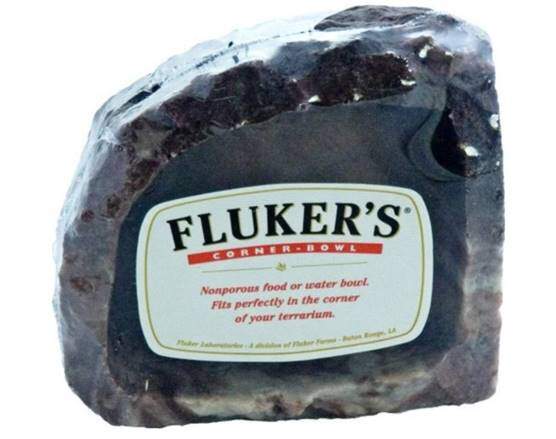
7. AROYEL Reptile Bowl
The AROYEL watering a dish can round up as a mealworm feeder, snack holder for beardies, gecko, and other small reptiles and amphibians. It is natural-looking, does not tip easily, and it will not absorb bacteria or give them a breeding place.
Its inner side is smooth and seamless for easy cleaning, is made from resins making it super safe and will blend well with your other vivarium décor.

8. Lixit Reptile Waterer
It features a reservoir and a drinking bowl to ensure constant water supply to your lizards, hermit crabs, chameleons, and iguana. Its broad base makes it anti-tip and has a screen to prevent crickets from entering into the reservoir. You can go for an eight or 16-ounce capacity reservoir.
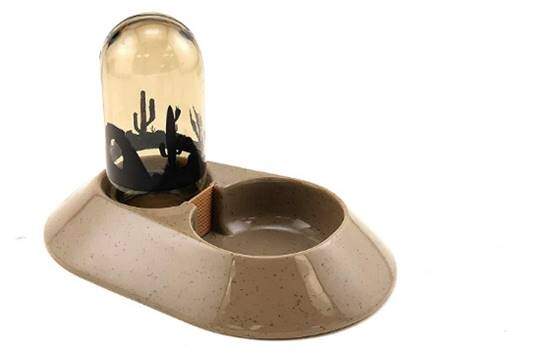
Misting your bearded dragon
A light misting or dripping a little vivarium and décor, especially early in the morning, may encourage these pets to lick droplets just as they do while in their natural habitat. However, you need to disinfect the various surfaces.
Also, if you spray water on their head, they will drink it like they do when it is raining, while if you spray on their tank, these reptiles may consume it like they consume dew, especially in the morning while in their natural habitat.
The Water Mister & Spray Bottle for Plants & Gardens or Fubarbar Plant Mister will do the work well. Also, mist their veggies, wet their dry food, and go for vegetables or food treats with high water content.
However, ensure you do not raise humidity since, even in their natural habitat, they thrive best under low humidity about 30-40% and not more than 55% at night. A hygrometer such as ThermoPro TP-60S Digital will be very important as it will also measure terrarium temperature.
Also, frequent misting may result in scale rot since their scales may trap water. Do it only a few times a week.
Finally, you can also go for a water dripper. Since these pets may not notice stagnant water, using a dripper may be more effective as it will mimic rainwater, and this pet will drink it like they do in the wild. The Zoo Med Little Dripper will do the work well. However, ensure you monitor humidity.
Myth:
Since their bodies always try to conserve water, no hydration can happen via their skin (unlike amphibians) or cloaca (rear orifice).[1] The keratin that their skin has makes it waterproof.
